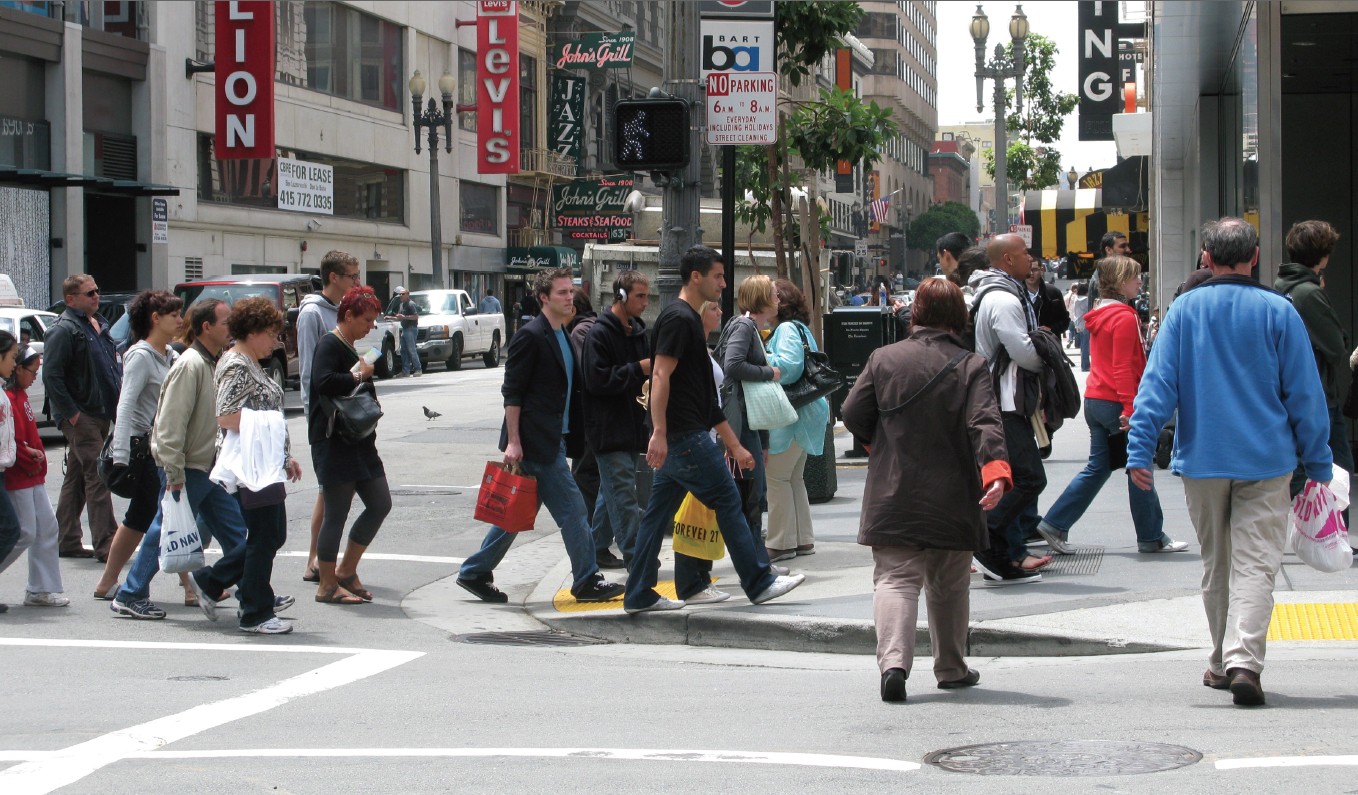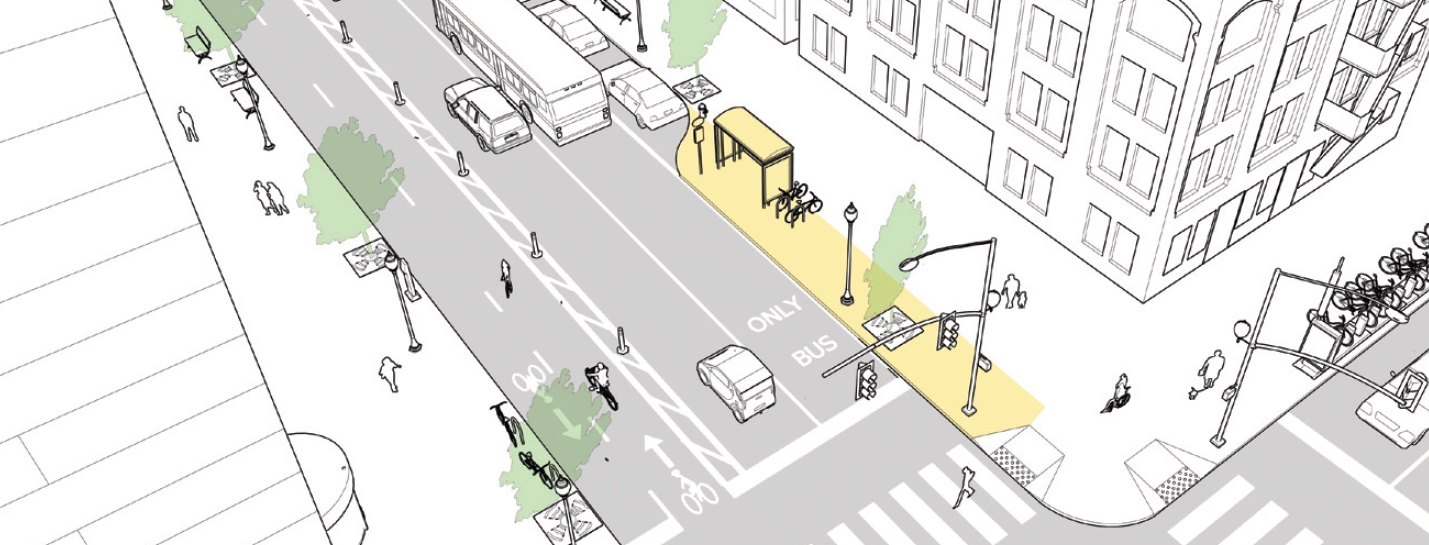
Cities’ challenges and burdens on their streets continue to multiply in quantity and complexity. Growing urban populations demand that their streets serve not only as corridors for the conveyance of people, goods, and services but also as front yards, parks, playgrounds, and public spaces. Streets must accommodate an ever-expanding set of needs. They must be safe, sustainable, resilient, multimodal, and economically beneficial, all while accommodating mobility demands.
In response to these unprecedented demands, cities around the country continue to develop an innovative body of practice and expertise to design for and around the special characteristics of the urban environment. From New York’s Times Square to Chicago’s Wacker Drive to Spring Street in Los Angeles, a better approach to and understanding of street design is taking root and becoming standard practice in our cities.
Using the Guide
Guideline Updates Since Release
The Urban Street Design Guide references national design standards and guidance that were current at the time of its publication (2013), but may have undergone updates since then. Readers should be sure to cross-reference the most recent editions of any guidance referenced. Certain sections of the Urban Street Design Guide reference material in its companion document, the Urban Bikeway Design Guide, second edition. Note that this guide has been updated, and is now in its third edition.
The contents of this guide have been formatted so that a reader may engage with the material in a nonlinear fashion. While each section provides varying degrees of detail and information, these sections present individual topics which do not require a complete reading of the material that precedes it.
Levels of Guidance

For most topics and treatments in this guide, the reader will find three levels of guidance.
- Critical Features are elements for which there is a strong consensus of absolute necessity.
- Recommended Features are elements for which there is a strong consensus of added added value.
- Optional Features are elements that may vary across cities and may add value, depending on the situation.
Note: Certain sections contain a general discussion only and have no critical, recommended, or optional points.
Relation to Other National, State, and Local Design Guidelines
The Urban Street Design Guide focuses on the design of city streets and public spaces. The Urban Street Design Guide emphasizes city street design as a unique practice with its own set of design goals, parameters, and tools.
In instances where a particular sign or marking should be used, the guide highlights its specific reference to the 10th Edition of the Manual for Uniform Traffic Control Devices (MUTCD) issued in 2009.
Many cities have already gone through the process of developing a local street design manual in the interest of creating internal design consensus between different local agencies. NACTO references materials from a selection of these guides and urges municipalities to use the Urban Street Design Guide as a basis for the creation of local standards.
It is important to note that urban situations are complex. The treatments and topics discussed in this guide must be tailored to individual situations and contexts. NACTO encourages good engineering judgment in all cases. Decisions should be thoroughly documented. To assist with this, this guide links to references and cites relevant materials and studies.
Approval for Federally-Funded Projects
Less than a year after NACTO released the Urban Street Design Guide, the U.S. Department of Transportation endorsed its vision for safe, sustainable, city-friendly street designs. Federal support for the Guide ensures that practitioners have both the permission and the flexibility to design streets that support safe walking and biking, as well as efficient transit.
The Infrastructure Investment and Jobs Act of 2021–also known as the Bipartisan Infrastructure Law–goes further, explicitly permitting cities to use the Urban Street Design Guide when implementing federally-funded projects on city-owned streets. Cities may do so without state permission.
To comply with the law, cities should formally adopt the Guide via a stand-alone departmental memo, a legislative resolution or ordinance, or through reference in their existing design guidance.
Endorsements
The Urban Street Design Guide has been endorsed by the United States Department of Transportation, nine state departments of transportation, dozens of cities, and organizations including the Association of Bicycle and Pedestrian Professionals, Congress for New Urbanism, and Urban Land Institute.
City Endorsements
Dozens of cities throughout the United States and Canada have endorsed the Urban Street Design Guide or adopted the design guidance to be used by their city transportation officials, engineers, planners, and consultants.
The following cities have endorsed or adopted the Urban Street Design Guide:
- Alexandria, VA
- Arlington, VA
- Atlanta, GA
- Austin, TX
- Baltimore, MD
- Bellevue, WA
- Bloomington, IN
- Boston, MA
- Boulder, CO
- Brownsville, TX
- Burlington, VT
- Charlotte, NC
- Chattanooga, TN
- Chicago, IL
- Davis, CA
- Denver, CO
- Des Moines, IA
- Detroit, MI
- Durham, NC
- El Paso, TX
- Fort Lauderdale, FL
- Hoboken, NJ
- Houston, TX
- Indianapolis, IN
- Los Angeles, CA
- Louisville, KY
- Memphis, TN
- Milwaukee, WI
- Minneapolis, MN
- Nashville, TN
- New York, NY
- Newark, NJ
- Oakland, CA
- Philadelphia, PA
- Phoenix, AZ
- Pittsburgh, PA
- Portland, OR
- Portsmouth, NH
- Providence, RI
- Rochester, NY
- Salt Lake City, UT
- San Antonio, TX
- San Diego, CA
- San Francisco, CA
- San José, CA
- San Mateo, CA
- Seattle, WA
- Somerville, MA
- Spokane, WA
- St. Paul, MN
- Tacoma, WA
- Traverse City, MI
- Ventura, CA
- Washington, DC
Has your city officially adopted or endorsed the Urban Street Design Guide? Contact us and we’ll add you to the list!
State Endorsements
State DOTs that have endorsed the Urban Street Design Guide include: